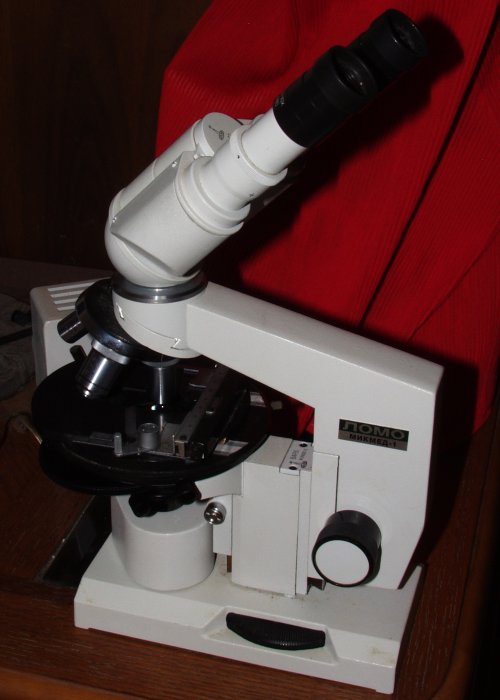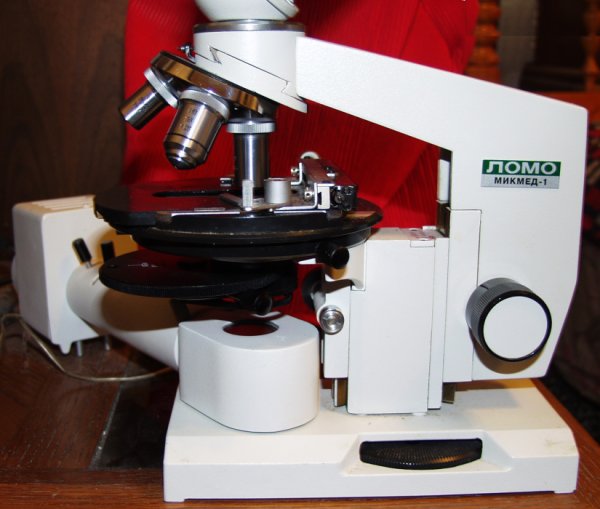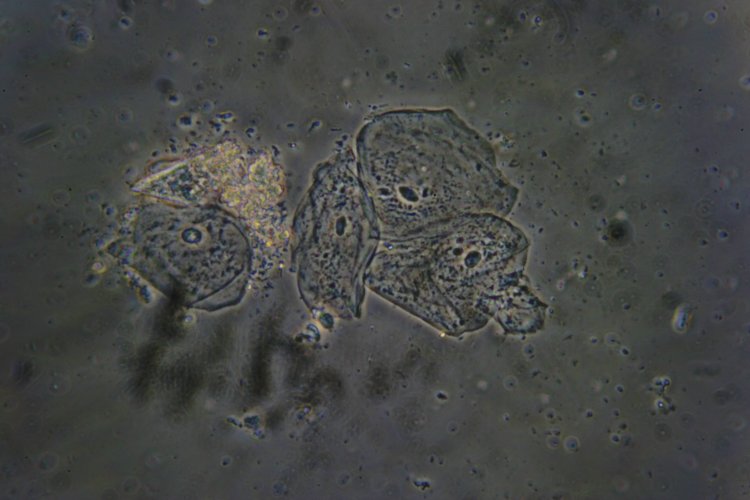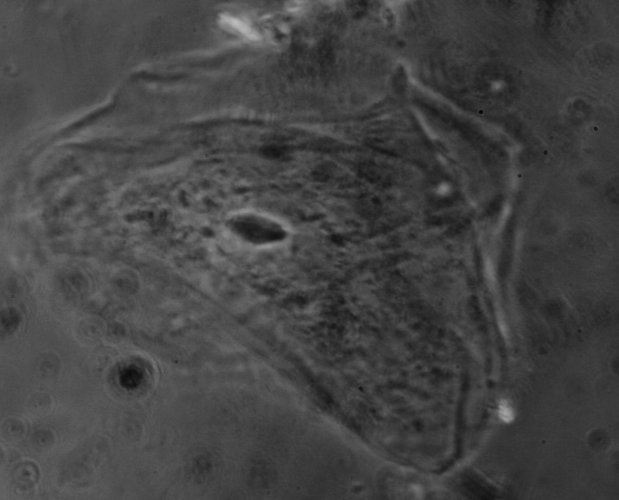
After the collapse of the Soviet Union there was a period when one could obtain LOMO microscopes and accessories for amazingly small sums. In fact, some of this equipment remains a bargain even today. Most of it has extraordinarily high quality optical parts, quite good mechanical parts, and absolutely dreadful electrical parts.
LOMO produced a modular microscope that was available during that period. In fact, it is possible to locate these instruments even in 2007, though later models seem to have been "stripped down" relative to early ones. Many of these have been sold around the world under the names "Mikmed" or "Biolam". The image below shows one of these instruments.

LOMO had a well deserved and earned reputation throughout the Soviet block for making high quality optical parts, and their phase contrast systems generally lived up to that reputation.
There were at least two different types of full sets of phase objectives that were available when I purchased my set. Each was complete with a phase condenser, a phase ring centring telescope, a dark green filter, and four phase objectives.
At that time, one of the sets sold for about $US250 and had RMS (31 mm) objectives! The second sets were more expensive and sold for about $US750 and had DIN (45 mm) objectives.
I purchased the RMS set. It really does not matter whether a set of objectives are RMS, JIS, or DIN, as long as all the lenses in the set belong to the same focal group!
The set came in an extremely poor carrying case. It had low grade wooden sides and a particle board lid and bottom! Fortunately, however, the equipment inside was dramatically unlike its case. In fact, everything inside was of very high quality. All of the components are labelled with Cyrillic letters, and the instruction set that came with it was in Russian only.
The phase telescope is very good, similar to ones made by other manufacturers.
The phase condenser is painted with a peculiar texturised paint that has a rather attractive high quality appearance. The metal parts are made from quite high quality metal and they are well fabricated. The lenses are first rate. The phase turret has five positions, one for each of the provided objectives, 10X, 20X, 40X, and 90X, and one for using without phase. There is a high quality iris in the system. The design of the phase turret is unusual in that the centring screws move the entire turret instead of the individual phase rings! This arrangement works surprisingly well. It is odd that other manufacturers do not design them this way. The turret turns easily, and has click stops that have no play at all. The centring thumb screws, unlike all the rest of the assembly, are made of fairly low quality plastic. However, if they should break, one could fabricate replacements in a few minutes. It is odd that the 20X and 40X phase rings are both the same diameter. However, the one for 20X is much thinner than the one for the 40x. One can use either with either lens, however.
The image below this text shows the set installed on the LOMO microscope.

The objectives are as follows:
The image below shows cheek epithelial cells using the 40x objective from this set.

I have always used these on a Mikmed (or Biolam) LOMO microscope. All four of the objectives are quite good, all four objectives produce dark contrast. They all require compensating oculars. When these are used with a 10X 18 field number LOMO compensating ocular the field is rather like a dinner plate. It is flat except at the very edge. Some phase objectives produced by other manufacturers produce poor contrast, however, all four of these are all excellent.
My LOMO microscope came with the well known "strange" external Koehler illuminator. (This device now sells for more than my LOMO microscope equipped with four apochromatic lenses did when I purchased it several years ago!) Until I replaced the horrible Russian bulb in it with LEDs, it was impossible to get a good image with ANY objectives. The improvement on changing to LED illumination was amazing! With LED illumination one can get true Koehler illumination that is even across the field. I made two LED holders, one carries a 3 watt white LED, the other a 3 watt 550 nm green one. Both provide extraordinarily good images with all four of these objectives. When properly adjusted, the field is evenly illuminated with all four of them.
The 90x phase oil immersion lens is of high quality. In fact, this lens seems to perform better with aqueous samples than most other high power oil immersion phase contrast lenses. The primary advantage of phase contrast is that it enables one to observe living cells, but oil immersion lenses require that the cells either be immersed in oil or be within a few nanometres of the cover slip. All manufacturers, not just LOMO, should provide WATER immersion lenses instead of oil immersion lenses with phase sets like this! LOMO optical designers were wise to produce this lens with a 1.25 n.a. instead of 1.3.
LOMO has produced high quality water immersion phase contrast lenses. I was able to obtain one of these some time ago. These are apochromatic 70x lenses with na of 1.23. Like most apochromatic lenses, these produce extraordinarily sharp images with fairly strong field curvature. The images of living bacteria with such lenses are nothing short of amazing. In fact, I have never seen any better lens for high power observation of aqueous specimens. The contrast is exceptional. Unfortunately none of the four phase rings in this set match the phase ring of these wonderful lenses!
The image below shows cheek epithelial cells with this 70x phase lens in green light. Because of the extreme narrow depth of field it is difficult to capture an image that begins to justice to the visual impression given by this lens.

Until recently, I was not able to use this LOMO water immersion lens on my LOMO microscope because I did not realise that there was enough clearance between the unusual LOMO illuminator and the condenser. When I realised that this was a feasible solution I machined a special phase ring system from aluminium. I described making somewhat similar phase rings for using this lens on an Olympus BHA microscope in the June 2007 issue of Micscape.
The images below show the LOMO version, with the image on the right showing it in place. The diameter of the hole in the centre is very critical, as is the diameter of the small brass disk. (I used brass for this simply because it is much easier to make small parts out of brass than aluminium.) A piece of brass stock was first turned down to the correct size in a lathe, and then cut off forming a tiny brass "coin." This was cemented to a large circular cover slip with epoxy resin. After it was cured this was cemented to the aluminium body. Note the handle, it is difficult to centre this type of phase ring without it!

Thus, my overall impression of the LOMO phase system is very very high. Not only are the four lenses in the set outstanding, the water immersion lens obtained separately much later is truly extraordinary. I usually have my LOMO microscope set up with this phase system. With the wide field oculars it is an excellent instrument for observing micro organisms.
Until recently I tended not to use my LOMO microscope very much because the left eye tube admitted stray light through the side of the prism at its base. This caused comet like images to appear on the side of image when wide field eyepieces were used. (Those with field number 18 or so.). I like to use wide image eyepieces, because I can find things on slides much easier. This problem was particularly annoying with phase contrast, because phase is generally used for observing living organisms, and they keep moving around, and are hard to locate and keep in the field without the widest possible field of view.
Several years ago I tried to remedy this situation by putting a field stop into the left eye tube. I tried to cut paper stops, and I came to the conclusion that any stop small enough to stop the stray light would also cause vignetting. Recently I decided to try to revisit the problem using aluminium stops. I machined an aluminium ring to make a precision fit into the left eye tube. When I first tested it I had a 10mm hole in this ring. There was severe vignetting with an 18 field number eyepiece and 10x objective. I returned the ring to the lathe and bored the ring out to a full 13mm. There was still significant vignetting. I returned the ring again and again to the lathe, now increasing the hole radius each time by only 0.25 mm. Eventually there was absolutely no vignetting, and I could see that if the ring had had to have been more than a fraction of a millimetre larger it would have admitted the stray light again! I painted the resulting ring flat black and installed it permanently inside the left eye tube. I had completely eliminated the only serious problem this instrument had! Furthermore, there was absolutely no vignetting at all, even with the 10X objective and 10x 18mm field number ocular combination.
Although the total cost of this entire system was less than just one phase objective from the other major manufacturers, these lenses match or exceed about any other phase objectives I have ever used for quality. Unfortunately it is becoming difficult to locate sets like this, and when they appear the price seems to be about double it was several years ago.
All comments to the author Robert Pavlis are welcomed.
Microscopy UK Front Page
Micscape Magazine
Article Library
Please report any Web problems or offer general comments to the Micscape Editor .
Micscape is the on-line monthly magazine of the Microscopy UK website at Microscopy-UK